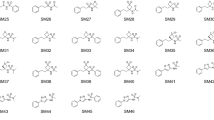Abstract
Computer models of hemagglutinins from the H3N2 and H7N9 influenza viruses were developed to study structural organization and dynamic characteristics of the binding site for the conformational rearrangement inhibitors. The metadynamics was used to map the binding site free energy and to define the volume of its most energetically favorable states. It was demonstrated by simulation of the umifenovir (Arbidol) interaction with hemagglutinin that ligand binding requires an increase in the binding site volume and deformation of its most energetically favorable state. We also identified amino acid residues directly involved in the ligand binding that determine the binding efficiency, as well as the dynamic behavior of the binding site. The revealed features of the binding site structural organization of the influenza virus hemagglutinin should be taken into account when searching for new antiviral drugs capable to modulate its functional properties.






Similar content being viewed by others
Abbreviations
- CV:
-
collective variable
- HA:
-
hemagglutinin
REFERENCES
Skehel, J. J., and Wiley, D. C. (2000) Receptor binding and membrane fusion in virus entry: the influenza hemagglutinin, Ann. Rev. Biochem., 69, 531-569, doi: 10.1146/annurev.biochem.69.1.531.
Hensley, S. E. (2014) Challenges of selecting seasonal influenza vaccine strains for humans with diverse pre-exposure histories, Curr. Opin. Virol., 8, 85-89, doi: 10.1016/j.coviro.2014.07.007.
Hensley, S. E., Das, S. R., Bailey, A. L., Schmidt, L. M., Hickman, H. D., Jayaraman, A., Viswanathan, K., Raman, R., Sasisekharan, R., Bennink, J. R., and Yewdell, J. W. (2009) Hemagglutinin receptor binding avidity drives influenza A virus antigenic drift, Science, 326, 734-736, doi: 10.1126/science.1178258.
Heider, A., Mochalova, L., Harder, T., Tuzikov, A., Bovin, N., Wolff, T., Matrosovich, M., and Schweiger, B. (2015) Alterations in hemagglutinin receptor-binding specificity accompany the emergence of highly pathogenic avian influenza viruses, J. Virol., 89, 5395-5405, doi: 10.1128/JVI.03304-14.
Tharakaraman, K., Raman, R., Viswanathan, K., Stebbins, N. W., Jayaraman, A., Krishnan, A., Sasisekharan, V., and Sasisekharan, R. (2013) Structural determinants for naturally evolving H5N1 hemagglutinin to switch its receptor specificity, Cell, 153, 1475-1485, doi: 10.1016/j.cell.2013.05.035.
Lvov, D. K., Bogdanova, V. S., Kirillov, I. M., Shchelkanov, M. Yu., Burtseva, E. I., Bovin, N. V., Fedyakina, I. T., Prilipov, A. G., Alhovsky, S. V., Samokhvalova, E. I., Proshina, E. S., Kirillova, E. S., and Syroeshkin, A. V. (2019) Evolution of pandemic influenza virus A(H1N1)pdm09 in 2009-2016: dynamics of receptor specificity of the first hemagglutinin subunit (НA1), Vopr. Virusol., 64, 63-72, doi: 10.18821/0507-4088-2019-64-2-63-72.
Russell, R. J., Kerry, P. S., Stevens, D. J., Steinhauer, D. A., Martin, S. R., Gamblin, S. J., and Skehel, J. J. (2008) Structure of influenza hemagglutinin in complex with an inhibitor of membrane fusion, Proc. Natl. Acad. Sci. USA, 105, 17736-17741, doi: 10.1073/pnas.0807142105.
Kadam, R. U., and Wilson, I. A. (2018) A small-molecule fragment that emulates binding of receptor and broadly neutralizing antibodies to influenza A hemagglutinin, Proc. Natl. Acad. Sci. USA, 115, 4240-4245, doi: 10.1073/pnas.1801999115.
Kadam, R. U., and Wilson, I. A. (2017) Structural basis of influenza virus fusion inhibition by the antiviral drug Arbidol, Proc. Natl. Acad. Sci. USA, 114, 206-214, doi: 10.1073/pnas.1617020114.
Han, N., Mu, Y., Miao, H., Yang, Y., Wu, Q., Li, J., Ding, J., Xu, B., and Huang, Z. (2016) The 340-cavity in neuraminidase provides new opportunities for influenza drug development: a molecular dynamics simulation study, Biochem. Biophys. Res. Commun., 470, 130-136, doi: 10.1016/j.bbrc.2016.01.007.
Maier, J. A., Martinez, C., Kasavajhala, K., Wickstrom, L., Hauser, K. E., and Simmerling, C. (2015) ff14SB: improving the accuracy of protein side chain and backbone parameters from ff99SB, J. Chem. Theory Comput., 11, 3696-3713, doi: 10.1021/acs.jctc.5b00255.
Case, D. A., Babin, V., Berryman, J., Betz, R. M., Cai, Q., et al. (2014) Amber 14, University of California, San Francisco.
Barducci, A., Bonomi, M., and Parrinello, M. (2011) Metadynamics, WIREs Comput. Mol. Sci., 1, 826-843, doi: 10.1002/wcms.31.
Tribello, G. A., Bonomi, M., Branduardi, D., Camilloni, C., and Bussi, G. (2014) PLUMED 2: new feathers for an old bird, Com. Phys. Commun., 185, 604-613, doi: 10.1016/j.cpc.2013.09.018.
Sanner, M. (1999) Python: a programming language for software integration and development, J. Mol. Graph. Model., 17, 57-61.
Morris, G. M., Huey, R., Lindstrom, W., Sanner, M. F., Belew, R. K., Goodsell, D. S., and Olson, A. J. (2009) AutoDock4 and autoDocktools4: automated docking with selective receptor flexibility, J. Comput. Chem., 16, 2785-2791, doi: 10.1002/jcc.21256.
Trott, O., and Olson, A. J. (2010) AutoDock Vina: improving the speed and accuracy of docking with a new scoring function, efficient optimization, and multithreading, J. Comput. Chem., 31, 455-461, doi: 10.1002/jcc.21334.
Ester, M., Kriegel, H.-P., Sander, J., and Xu, X. (1996) A density-based algorithm for discovering clusters in large spatial databases with noise, Proc. 2nd Int.Conf. Knowl. Discov. Data Mining, AAAI Press, Portland, Oregon, pp. 226-231.
Durrant, J. D., Votapka, L., Sørensen, J., and Amaro, R. E. (2014) POVME 2.0: an enhanced tool for determining pocket shape and volume characteristics, J. Chem. Theory Comput., 10, 5047-5056, doi: 10.1021/ct500381c.
Humphrey, W., Dalke, A., and Schulten, K. (1996) VMD: visual molecular dynamics, J. Mol. Graph. Model., 14, 33-38, doi: 10.1016/0263-7855(96)00018-5.
Sadovnichy, V., Tikhonravov, A., Voevodin, V., and Opanasenko, V. (2013) “Lomonosov”: supercomputing at Moscow State University, in Contem. High Perform. Comp., Boca Raton, USA, pp. 283-307, doi: 10.1201/9781351104005-11.
Acknowledgements
The study was performed using the equipment of the Center of Collective Use of super high-performance computational resources of the Lomonosov Moscow State University [21].
Funding
This work was supported by the Russian Foundation for Basic Research (project No. 18-315-00390).
Author information
Authors and Affiliations
Corresponding authors
Ethics declarations
This article does not contain studies with human participants or animals performed by any of the authors. The authors declare that they have no conflict of interest.
Rights and permissions
About this article
Cite this article
Podshivalov, D., Kirilin, E., Konnov, S. et al. Structural Organization and Dynamic Characteristics of the Binding Site for Conformational Rearrangement Inhibitors in Hemagglutinins from H3N2 and H7N9 Influenza Viruses. Biochemistry Moscow 85, 499–506 (2020). https://doi.org/10.1134/S0006297920040100
Received:
Revised:
Accepted:
Published:
Issue Date:
DOI: https://doi.org/10.1134/S0006297920040100




